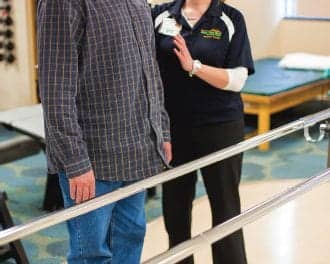
Emily Beus, PT, DPT, works with a patient in the computerized balance system at Magee Riverfront Outpatient Center in Philadelphia. (Photo courtesy Magee Rehabilitation.)
The ability of the central and peripheral nervous systems to maintain the body’s position over a base of support is no easy feat. Maintaining stability as you walk along a busy street on a cobblestone path is a complex process. Steady walking requires careful and constant integration of visual information, intact proprioception, and normal vestibular function to prevent loss of balance. Vision is required to help avoid other pedestrians, proprioception helps you stay steady as your foot lands on the cobblestone, and the vestibular system keeps you oriented to upright while quickly moving your head to assess a sound. When dysfunction in the balance system arises, people often complain of dizziness, imbalance, blurry vision, sensitivity to light, motion sensitivity, nausea, aural fullness, tinnitus, and headaches. Vertigo and disequilibrium often result in functional limitations including the inability to complete activities of daily living (ADLs) such as self-care, cooking, and cleaning. Vestibular and balance dysfunction may result in the inability to drive, work, or parent effectively. Over time, these limitations lead to decreased access to the community and poor quality of life.
Research suggests up to 35% of adults age 40 years and older in the United States have experienced some form of vestibular dysfunction, making it a very costly problem to society.1 Vestibular dysfunction may lead to an increased risk of falls and inability to work. Evidence indicates 20% to 30% of people who fall suffer moderate to severe injuries such as hip fractures and brain injuries. These morbidities may result in further loss of independence and increase the individual’s mortality rate.2
DISCOVERING THE SOURCE OF DYSFUNCTION
Causes of dysfunction in the balance system are many and can include impaired sensory input, problems with central processing, and inappropriate motor output. Vestibular dysfunction arises from specific problems in the peripheral or central apparatus leading to inadequate integration of sensory systems that help maintain stability. The peripheral apparatus is located in the inner ear and the central apparatus consists of areas throughout the brain and brainstem.3 Vestibular dysfunction can be exacerbated by comorbidities where vision and sensory systems are impeded, as in diabetes. Diabetes often leads to peripheral neuropathy and cataracts, causing sensory loss of the feet and poor visual acuity.
Patients may be referred for vestibular function testing as part of electronystagmography (ENG) by an audiologist when symptoms occur. Testing assists with confirming a suspected vestibular loss, helps identify the severity of loss, and determines if the loss is located in the central or peripheral vestibular system. Caloric testing is useful for determining the laterality of the defect and which system is affected. Rotary chair testing aids in detecting bilateral peripheral vestibular loss and confirms central compensation from vestibular rehabilitation.4
Vestibular rehabilitation has been found to significantly reduce functional disability associated with dizziness and balance disorders.5 Primary objectives of vestibular rehabilitation are to decrease persistent dizziness and postural instability following peripheral or central nervous system injury. Therapists focus on normalizing balance and maximizing the performance of the vestibulo-ocular reflex (VOR). The vestibular clinic at Magee Rehabilitation Hospital Outpatient Center in Philadelphia emphasizes a team approach in managing the patient’s symptoms. We maintain a close relationship with physicians and other disciplines to improve patient outcomes. Goals of treatment include returning to full independence, minimizing risk of falls, improving quality of life, and returning to work or recreational activities without restrictions. This facility’s practice consists of 75% chronic central dysfunction and 25% peripheral dysfunction including benign paroxysmal positional vertigo (BPPV). The most common diagnoses clinicians at this facility manage are post concussive syndrome, traumatic brain injury, cerebellar degeneration, stroke, and Arnold-Chiari malformation.
TECHNOLOGY FOR GUIDING CARE
A comprehensive assessment is paramount to creating an effective plan of care. Patients referred for a vestibular evaluation undergo a detailed past medical history and history of current illness. Specific information regarding the patient’s symptoms of dizziness and imbalance is obtained including frequency, duration, intensity, and their association to certain positions and activities. A thorough oculomotor examination is completed to assess for signs of central versus peripheral vestibular dysfunction. Frenzel goggles are very useful for improving the therapist’s ability to accurately confirm diagnosis of BPPV, presence of gaze evoked nystagmus, and abnormalities in eye range of motion, saccades, smooth pursuits, VOR, and convergence.
Following the oculomotor examination, a detailed and objective assessment of balance, vision, and gait is performed. At Magee Rehab, therapists have access to a computerized balance system that uses a dynamic force plate with rotation capabilities as a resource to obtain objective, reliable, and valid measurements. Patients undergo computerized dynamic posturography (CDP) testing at initial evaluation. The sensory organization test (SOT) assists with identifying the level of impairment and which components of the balance system are most compromised. Utilizing CDP helps improve efficacy of treatment and assists with goal setting. To quantify performance of the VOR, the patient is evaluated using specialized software that is a component of the computerized balance system. Computerized scores for dynamic visual acuity (DVA) and gaze stability (GST) speed are obtained for the left and right direction to determine severity of injury. Weakened VOR performance is often observed in patients with dizziness and disequilibrium. A gross assessment of gait is completed with specific measurement of self-selected gait speed, as it correlates well with functional ability, balance confidence, and mortality.6 Traditional balance examinations are completed to supplement findings including the Dynamic Gait Index (DGI) and Timed Up and Go (TUG) test. Finally, to help associate objective and patient reported symptoms, self-perceived disability questionnaires are administered including the Dizziness Handicap Inventory (DHI), Post Concussive Symptom Scale (PCSS), Activities-specific Balance Confidence (ABC) Scale, Visual Analog Scale (VAS), and Motion Sensitivity Quotient Test (MSQ).
AFTER ASSESSMENT: TREATING DIZZINESS, BALANCE, AND BEYOND
Treatment strategies for decreasing dizziness and improving postural stability vary based on the objective findings of the initial evaluation. Education is critical, sometimes requiring a considerable portion of the patient’s sessions to address appropriate symptom management and pacing to maximize outcomes. A systematic review of the available literature has shown vestibular therapy to be effective in improving dizziness, gait, ADLs, gaze stability, and balance.7 Viewing exercises to increase accuracy of the VOR are completed regularly to encourage adaptation of the vestibular system for management of dizziness. During adaptation exercises, the patient focuses on a target while rapidly moving the head to maximize gaze stability. Substitution exercises focus on accurate eye to head movements when central vestibular dysfunction is severe. The computerized balance system’s software has been recently updated to allow the clinician greater control over VOR training. Speed, size of target, and background can be adjusted by the therapist to maximize benefit of VOR training while monitoring postural stability on the force plate. Habituation strategies are often used to decrease motion sensitivity by gradually working towards tolerance of activities that were previously avoided due to provocation of symptoms.
Vigorous balance training is completed to reintegrate vision, proprioception, and the vestibular system. Interventions focus on returning the patient to a midline position and appropriate use of ankle and hip strategies for balance recovery. Random, varying movements of the platform and surround in the computerized balance system challenge the patient’s vestibular system and improve sensory organization for decreased postural sway and motion sensitivity in complex environments.
Strengthening of the lower extremities and the core is another focus of treatment to maximize stability. When completed on the whole body vibration device in our clinic, which uses vibration as a modality, it may increase the effectiveness.8 Patients may work on maintaining appropriate posture in a narrow base of support or single limb stance for up to a minute while the vibration occurs during treatment sessions.
In several of our patients with chronic central vestibular dysfunction, we have observed immediate and clinically significant improvements in postural stability on the SOT with Balance-Based Torso-Weighting (BBTW). Similar findings have been documented in case studies among patients with multiple sclerosis.9 BBTW involves strategic placement of small, unobtrusive weights on an outer garment to counteract increased postural sway detected by the therapist during perturbation testing. Using BBTW, Magee Rehab therapists have observed functional improvements in patients previously thought to have reached a plateau.
Improvements in technology have allowed for more objective and clinically meaningful measurement of outcomes in vestibular rehabilitation. The SMART Balance Master system for balance and VOR assessment is a valuable tool used by Magee Rehab therapists in guiding interventions, and assists in evaluating the efficacy of treatment. Newer software allows us to provide more specific protocols for VOR training by providing patients with specific speed and size of target for optimal practice at home. We also feel strongly that our ability to educate patients has improved with these technologies. Decreased adherence with exercise programs following physical therapy interventions is well documented in older individuals. Adherence can be affected by intrinsic motivators like self-efficacy, and extrinsic barriers including lack of time or access.10 The latest technology allows us to provide our patients tangible evidence through graphical representations of their improved performance over time. We have witnessed an increase in patient engagement, which is crucial to supporting positive change in the self-perceived outcome measures administered at initial evaluation.
PLANNING FOR DISCHARGE
Preparing patients with vestibular dysfunction for discharge can be a daunting task. To ease the transition, we educate each patient from the initial evaluation about the expected duration of treatment, and importance of compliance with a home program, and emphasize the long-term goal of reaching independence in managing their condition. Each patient is provided a home exercise program at initial evaluation that is progressed weekly and is safe for them to complete independently or with assistance from a caregiver. Minimizing barriers is critical; 37% of older adults with a balance impairment who report having received a home exercise program no longer perform it at follow-up.8 Home programs are tailored to the individual but typically include balance activities to maintain increased stability, continued visual exercises to prevent decompensation, a regular walking program for cardiovascular health and habituation, and focus on return to previous community or societal roles to maintain benefits and encourage carryover. This may include return to driving, independent grocery shopping, return to yoga or regular exercise, or being able to walk their dog again. This rehab facility has a variety of other specialists available for consultation when patients do not improve as anticipated. Patients are encouraged to regularly attend follow-up appointments with their referring physician, and neuro-psychology, neuro-optometry, occupational therapy, speech therapy, and nursing are recommended as indicated.
ENGAGED FOR SUCCESS
Vestibular dysfunction is not simple to treat, as each patient brings their own complexities into the clinic. Undoubtedly, there are stumbles along the way, with recovery at times resembling a walk in stilettos down a cobblestone path. Emphasizing a team approach, focusing on patient education, and maximizing patient engagement are essential. New and developing technology aids in maximizing outcomes and, most importantly, returning the patient to full independence, when used judiciously. As clinicians, we must rely foremost on evidence-based practice to guide our treatments and remain dedicated to being educated consumers of novel technologies. RM
Emily Beus, PT, DPT, is a senior physical therapist at Magee Riverfront in Philadelphia. She is certified in vestibular rehabilitation through the American Physical Therapy Association and is a credentialed clinical instructor. She received her bachelor of arts from Southern Methodist University and Doctorate of Physical Therapy from Emory University.
Amanda Laarz, PT, DPT, is a senior physical therapist at Magee Riverfront in Philadelphia. She is certified in vestibular rehabilitation through the American Physical Therapy Association. She works closely with the Philadelphia Concussion Center at Magee Rehabilitation. Laarz received her bachelor of science in kinesiology from the University of Michigan and Doctorate of Physical Therapy from Drexel University. For more information, contact [email protected].





